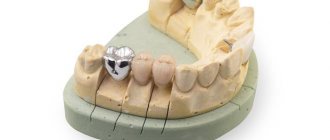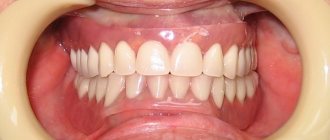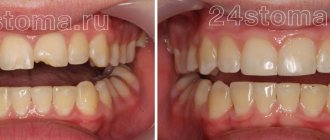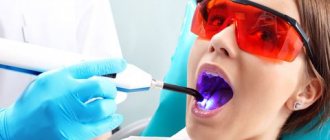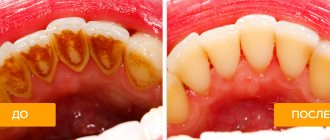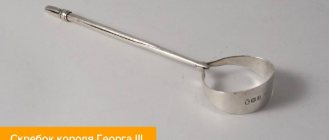- Veneers and facial proportions
- Articulator, occluder and facebow
- Veneer for one tooth
- Live or dead tooth - veneer or crown
- Zirconium veneers
- Veneers for crooked teeth
- Lumineers
- Veneering
- Dietary restrictions with veneers
- How to care for veneers
- Whitening before installing veneers
- Change (replace) veneers
We have already talked about the differences between composite and ceramic veneers, indications and contraindications for the installation of veneers, today we will continue the topic of artificial onlays on teeth and look at such concepts as “lumineers”, “veneering” and touch on other important points. Our interlocutor is Tamara Kazbekovna Alakaeva, maxillofacial surgeon, orthopedic dentist .
— Tamara Kazbekovna, they say that installing veneers helps solve problems not only with a smile, but also with age-related changes on the face. This is true?
Partly. Let me give you an example. We recently had a patient whose teeth were fine except for minor problems that could be corrected. But with age, the teeth on the lower jaw were worn away. Because of this, the load on the temporomandibular joint began to be distributed incorrectly. The lower third of the patient's face was low, the nasolabial folds were strongly pronounced, and the corners of the mouth were drooping. The face acquired an “senile” appearance. Some will say that you can consult a cosmetologist and solve age-related problems by introducing fillers, but one of the reasons for the formation of these age-related changes is an incorrect bite. We also found out from the patient’s medical history that he had severe tooth wear due to bruxism. That is, in this case, the patient’s teeth need to be restored to normal height.
In such cases, at the initial stage we use a facial bow apparatus, with its help we take an impression and install plaster models in the articulator apparatus.
— Tell us more about the articulator.
Using an articulator, we determine the position of the upper and lower jaws and the trajectory of movement of the lower jaw. As you know, our lower jaw moves, while the upper jaw always remains motionless. It is visually difficult to determine the features of the patient’s dental system. In such cases, the articulator helps.
For example, to determine the position of the upper jaw in relation to the skull, an impression of silicone material is taken and a face bow is installed. The facial arch runs along the pupillary line, the tragus of the ear and nose and on the teeth of the upper jaw. This way we can determine the position of the upper jaw in relation to the bones of the skull. The model is cast from plaster and installed in the articulator.
To determine the height of the lower jaw, we ask the patient to close the jaw and look at its position. Then we ask you to close your jaw so that only your lips touch each other, and your teeth do not close together. Determining the height.
Next, we determine the height of the facial part from the hair growth to the eyebrow border. Then from the eyebrow border to the columella of the nose and to the chin. The size must match. The height of a person’s forehead can change; for example, in men, a receding hairline may appear with age.
After the preparatory work has been done, we proceed to the jaw. It is necessary to raise the height of the lower jaw teeth gradually to avoid a large load on the temporomandibular joint. For two months, the patient walks with temporary veneers and temporary onlays on the chewing teeth. If he is comfortable and does not feel pain, then the temporary structures are replaced with permanent ones. This is a very large and lengthy job: we grind the teeth, do wax modeling, try on veneers, and correct the work.
- What if it’s just the opposite case? The patient is doing well, but he doesn’t like literally 1-2 teeth in the smile area. Is it possible to place only one or two veneers?
Such cases occur, for example, when a person may lose part of a tooth (severe chipping). Of course, we will do one or two veneers. But you need to understand that the fewer veneers we make, the more difficult it is for the dental technician to get the color right. That is, over time, it is possible that adjacent teeth will begin to differ.
— That is, one veneer in the smile area will be noticeable?
It all depends on the skill of the dental laboratory. We photograph the patient, and the dental technician necessarily conducts an examination in daylight and artificial light. In our practice, there was a case when a piece of the crown that was installed on the front tooth broke off. The difficulty was that the adjacent teeth were also artificial, and we did not know what material the adjacent crowns were made of. Technicians work with different masses and colors, each has their own approach and view, so, of course, it is very difficult to get the color of artificial teeth.
— It turns out that in such cases it is better to put veneers on all central teeth?
If a piece breaks off on one tooth, and the tooth next to it also doesn’t look aesthetically pleasing, then it makes sense to put veneers on both teeth.
— You said that veneers should be placed only on “living” teeth.
Yes, crowns should be placed on dead teeth. Depulped teeth become fragile, most often they are already destroyed, so the veneer here will not hold securely and provide functionality.
— How to treat teeth in case of caries if there are veneers on the teeth?
When installing a veneer, the back of the tooth is not affected. If the patient has any problems with this tooth, they can be easily solved since it is accessible.
What you can and cannot eat after installation of veneers and lumineers
If you have veneers and lumineers, the most important thing is to limit the load on the front teeth. That is, give up anything solid—excessive pressure can cause the plates to crack or peel off.
- do not bite off any food, even the softest. You need to get used to cutting or separating foods into small pieces - this applies to vegetables, fruits, meat, crackers and even cookies. Chew only with lateral teeth without overlays,
- give up the seeds - at least peel them by hand and chew them with your side teeth,
- use fibrous foods with caution - they can get stuck in the interdental spaces - it will be quite difficult to remove them with dental floss,
- it is necessary to abandon “coloring” foods (beets, red wine, black tea, coffee) or minimize their consumption, since the risk of changing the shade of dentures, especially composite and ceramic ones, significantly increases,
- Sudden changes in temperature (first eating hot meat, then drinking it with cold milk) are prohibited, as are too hot or cold foods and drinks - this can lead to cracks in the material and resorption of the composite glue. Ultimately, the overlay will simply come off.
There is absolutely no difference between veneers and lumineers in terms of care. They are fixed equally well, but veneers may fit the gum a little less tightly - the thicker the plate, the more “step” remains between the veneer and the mucous membrane. It can chafe and cause inflammation. Therefore, it is the gums that need to be given the most attention after restoration.
Basic recommendations
The rules for caring for veneers after their installation are no different from the basic requirements for oral hygiene in general.
A person does not need to change the organization and plan for allocating temporary resources for the day or constantly carry toothpaste, brush and mouthwash. But a number of important nuances must be taken into account.
The first thing you should pay attention to after restoration is nutrition. The consumption of products containing aggressive dyes (coffee, chocolate, beets, red wine) must be minimized. It is not necessary to completely exclude such food from the table, it is enough to simply reduce its consumption.
This is interesting: Caring for dentures - the subtleties of polishing and the tools used
Smoking with veneers is prohibited , otherwise nicotine, with its harmful effects, can quickly turn the snow-white color of beautiful teeth into a yellowish tint.
Remember, aesthetic veneers are not protective elements for teeth, so you should not overload them with excessive chewing pressure.
Avoid cracking seeds, cracking nuts, or using your teeth as a bottle opener. All this can compromise the integrity of the veneers and harm healthy units.
Active sports require the installation of a special protective mouthguard that will protect the pads from mechanical damage.
Let us consider in detail the important nuances of caring for veneers.
How to brush teeth with veneers?
- Replace all hard brushes with soft or ultra-soft ones. Rough bristles can damage the surface. The same applies to toothpastes with abrasive particles, the so-called whitening ones.
- Dental floss and irrigator should be used as often as possible, every time after eating. It is important to remove food particles and accumulated plaque very carefully so that it does not get clogged into microcracks and the gap between the gums.
- Don't neglect your mouthwash. Any one is suitable for strengthening gums or sensitive enamel.
- Professional teeth cleaning is recommended every three months. It is better to do it in high-level dentistry, where they know exactly how to work with this type of veneers.
Patients after microdental prosthetics are always warned about possible problems with the gums. If you neglect hygiene, the risk of developing inflammation at the junctions with the mucous membrane increases. Any irritation, swelling or redness is a reason to consult your specialist. Otherwise, the process will go too far and then you will have to remove the veneers until the gums heal.
Did you notice roughness on the surface, did it seem that the lining was not tightly attached to the tooth? Go to the dentist immediately. The doctor will be able to assess the extent of the damage and attach the veneer to the tooth. Otherwise, plaque will accumulate in the cracks, which will cause caries. Then you will definitely have to remove the plates and wait until the tooth is treated.
Using an irrigator
An irrigator is what you need if veneers are installed in the oral cavity. Using it, you raise the quality of teeth cleaning to a higher level. The irrigator can clean 2 times more plaque than a regular toothbrush. It cleans not only the surfaces of the teeth, but also the places where the dentures are adjacent to them, as well as the mucous membrane of the gums and tongue.
The operation of the device is based on the principle of supplying liquid under pressure through a special nozzle. The jet directed at the tooth perfectly washes away plaque and massages the gums, stimulating blood circulation.
Dietary restrictions
The condition of veneers is negatively affected not only by the coloring and hard foods mentioned above, but also by highly acidic foods. For this reason, dentists strongly recommend making minor adjustments to your daily diet.
Remarkable! You should eat fibrous foods with caution, because... it can get stuck in the spaces between the teeth, and eliminating it even with the help of special devices is quite problematic.
If dental floss is used for these purposes, it is important not to place it vertically, i.e. do not move from the gums to the edges, so as not to damage the aesthetic pads.
Caring attitude
Taking good care of veneers involves, first of all, avoiding impacts and injuries.
Also, after the restoration procedure, a person with a Hollywood smile needs to be regularly seen by a dentist. If rough areas appear on the products, unevenness is an alarming signal to immediately visit the clinic. Such defects are potentially dangerous and can cause the development of caries and other serious diseases.
Patients suffering from bruxism should pay close attention to the care of the plates. This disease is a contraindication to the installation of onlays, however, if restoration and restoration of teeth in this way was necessary, it is important to wear a special mouthguard while sleeping at night.
It is necessary to visit the dentist periodically for professional teeth cleaning. Only a specialist can qualitatively remove plaque that has been left unattended in the most inaccessible areas of the dentition.
Visiting the dentist
Even if you are 100% sure that you are taking the best possible care of your teeth, be sure to visit your dentist at least twice a year and schedule a professional teeth cleaning every 3 months.
Regular medical examinations and oral health checks by a qualified hygienist help to recognize emerging problems early. It is advisable to consult a doctor who has experience caring for veneers.
This is interesting: Dental bridge: types, which is better, how they are made and installed, how much a bridge costs
What hygiene products should you have in your arsenal?
Hygiene products after installation of veneers and lumineers
| Name | Description |
| Toothbrush | Only with soft bristles - use it to clean the very surface of veneers and lumineers. Too hard hairs can lead to cracks. The teeth themselves can be brushed with a regular, medium-hard brush. Do not use electric brushes specifically for teeth with veneers - vibration can lead to the veneers coming off. Again, such brushes use quite aggressive bristles and even plastic elements that can damage the material and make it rougher - you should definitely avoid such attachments. |
| Toothpaste | Without the addition of abrasive particles (not bleaching!), such a paste can also lead to the formation of microcracks on the surface of the dentures. |
| Irrigator | Allows you to clean both the interdental spaces and the surface of the veneers from plaque. An additional bonus is a massage of the gums - the mucous membranes are saturated with oxygen, metabolic processes in them are restored. |
| Mouthwash | Choose the product that you need, taking into account your existing problems: to combat gum inflammation, to reduce tooth sensitivity, to strengthen enamel (with fluoride). |
Why is it better to do whitening after filling, but before prosthetics?
If you want to undergo a whitening procedure, but also have a filling, you still need to take care of your dental health first. For example, professional in-office whitening is carried out only after removing plaque and deposits, installing fillings or replacing them. You should immediately discuss your plans with your doctor and select the material of the desired shade.
As for prosthetics with crowns, this procedure can be carried out after bleaching. This will make it easier to choose a ceramic shade that exactly matches the current enamel color.
How to properly brush teeth with veneers and lumineers
There is nothing special here: in the morning before breakfast and in the evening after all meals using a brush (how to choose it - see the sign above) and paste. Complete the complex with the use of an irrigator, and finally rinse the mouth with mouthwash.
After each meal, it is mandatory to remove any leftover food. Preferably again with the help of an irrigator. It is important to maintain the condition of not only the veneers, but also the teeth underneath them, as well as the gums. Remember that even with dentures, teeth are destroyed - you can simply lose them.
Can I use dental floss?
There are no clear prohibitions on the use of dental floss and interdental brushes, but you need to be extremely careful when using them. After prosthetics, microgaps between teeth are naturally preserved. But here it is very important not to move the thread from the gums to the edges (i.e., not to make vertical movements) - of course, not immediately, but gradually due to such actions the lining can be damaged. If you want to use floss, insert the tip not from below (from the cutting surface), but directly into the area between the teeth in the gum area - into the largest gap. After cleaning, remove it in the same way.
The same with brushes - when you remove them from the interdental space, be extremely careful. Choose the thinnest brushes. And best of all, buy an irrigator. This is an excellent replacement for both dental floss and brushes.
“Pay special attention to the condition of the gums, especially where the mucous membrane comes into contact with the edge of the veneer or lumineer. Due to tissue injury, inflammation may occur, which will lead to the fact that the pads will have to be removed for treatment, or due to a violation of aesthetics. For example, if gum recession begins and the roots of the teeth become exposed.”
Dzhutova Aida Vladimirovna Implant surgeon, periodontist Work experience more than 9 years make an appointment
Do you dream of a beautiful smile? We have developed COMPLEXES of veneers for the smile area - place 4, 6 or 12 onlays at once! Save up to 30 thousand rubles and get a Hollywood smile!
sign up now
Lifetime
The duration of operation of the plate, which replaces the outer layer of teeth, depends on its strength.
Composite products are made from high quality composite filling composition. Patients prefer such products because of their affordable cost; moreover, this type of restoration can be used by any dentist.
But you shouldn’t count on long-term cosmetic effects. Such products remain on the surface of dental elements for no more than 5 years and quickly change their original shade.
Ceramic veneers have a longer service life. Due to their good resistance to staining and stress, such plates serve their owner for at least 15 years , and with good care this period can be doubled.
The effectiveness of dental restoration with plates depends on the following factors:
- material used in manufacturing;
- physiology of teeth;
- individual structural features of the dentofacial apparatus;
- food consumed by the patient;
- compliance with the recommended rules for caring for products.
The video provides additional information on the topic of the article.
Is it possible to carry out professional hygiene with veneers and lumineers?
Not only is it possible, but it is also necessary. When performing hygiene, be sure to remind the doctor that you have dental veneers installed in order to select a gentle ultrasonic treatment mode. Frequency – 1-2 times a year or as needed, depending on the quality of home care. But many patients, after installing veneers, carry out hygiene without effort, i.e. They treat renewed teeth with care, which causes plaque to accumulate faster. So you need to be prepared for the fact that you will have to undergo comprehensive cleaning even more often.
Air Flow technology is prohibited because abrasive particles are used - they can damage the smooth surface of the pads. Remember about home hygiene - this is the only way to maintain the health of your teeth and the condition of your microprostheses.
Reasons for darkening of the linings
In some cases, after aesthetic restoration of teeth with veneers, patients notice their darkening after some time. Such products are made of ceramics and composite, the latter of which tends to change the original shade during use.
In such a situation, a complete replacement of the microprosthesis is required, since bleaching procedures for such material are ineffective.
Ceramics does not tend to darken over time, but in exceptional cases this material also changes color.
This problem occurs in the following cases:
- The adhesive base has broken .
Ceramic bases are resistant to the effects of pigments, however, they do not have complete protection against changes in shade. Due to the destruction of the fixing substance between the tooth and the veneer, particles of coloring food form a bacterial plaque, which changes the color of the enamel of natural units. A thin overlay is not able to hide this defect, because... completely imitates the structure of the surface layer due to its light transmittance. - Excessive care of the pads. Most patients take special care of installed products, wanting to extend their service life in this way.
For this purpose, they use bleaching agents with a chemical and highly abrasive composition, hard toothbrushes and other devices with an aggressive effect.Such care causes the formation of microcracks, abrasions and other damage on the surface of the linings, which facilitate the penetration of coloring substances into the structure of the product.
Remarkable! It is not always possible to remove the overlay without deforming it, so more often than not, when a darkening problem occurs, a specialist installs a new structure.
Is it possible to smoke if you have veneers?
Of course, you need to give up smoking. Firstly, for the general health of the body. Secondly, in order to preserve the color of the veneers. Of course, they will darken along with the enamel of living teeth, so there will be no obvious contrast. But unlike natural teeth, they cannot be whitened – the process is irreversible. Thirdly, when smoking, the gums suffer greatly - with veneers, the risk of mucosal recession increases, and when smoking it is even higher. Therefore, if possible, it is still better to give up this bad habit. Or at least strengthen hygiene and visit a doctor for comprehensive cleaning 2-3 times more often.
Is it possible to lighten an artificial tooth that has been made too dark?
No, you won't be able to do this. After all, the shade of the ceramic is selected at the stage of making the prosthesis - then the product is baked in an oven, and the color is fixed forever. If the dentist made a mistake with the shade, then he will either have to redo the prosthesis (change the ceramic lining on a metal-ceramic crown, for example), or even make a new orthopedic structure.
There is another option - to apply a special white varnish on top of the ceramic prosthesis (for example, Dental Paint). It will paint the crown or veneer only on top, and after several cleanings it will wash off. Therefore, such a solution to the problem cannot be called a high-quality solution.
How do you know when it’s time to change veneers?
Monitor the condition of the veneers, the quality of their fixation on the teeth, pay attention to microcracks, gaps and roughness - even in a small gap between the veneer and the enamel, bacteria will accumulate, which will lead to the destruction of living tooth tissue. Do not forget that in order to maintain the warranty on the product, you need to visit the dentist every six months - he will be able to assess the condition of the veneers and the teeth under them. He will also clarify that it is time to update the prostheses. However, this may be required after at least a couple of years if you do not take care of hygiene, and at least after 10 years (depending on the material) if you take care of your new teeth.
Choosing between veneers and lumineers? Only original Cerinate and DUO lumineers. No fakes, 100% quality guarantee.
sign up now
Important points
Another positive aspect of the dental reconstruction technique is a change for the better in the condition of the gums, by ensuring an accurate fit of the contours of the onlays to the gum tissue.
However, the opposite effect often occurs. Inflammation begins to develop in the gums, bleeding and pain occur. The manifestation of these symptoms occurs when an error or error is made during the installation of microprostheses.
You should contact your dentist if, after the placement of veneers, the following occurs:
- plate mobility;
- swelling or swelling of the gum tissue;
- pain;
- discomfort;
- caries on uncovered tooth surfaces;
- bleeding gums;
- roughness or gap in the place where the structure is secured;
- chipping off part of the lining.
If the listed problems are detected, the specialist is obliged to adjust the position of the microprosthesis or replace it with a new one.
Can veneers and lumineers be whitened?
No, veneers, lumineers and any filling materials (composites) cannot be whitened. The chemical properties of the gel allow it to penetrate only between the tissue cells of natural teeth. During cleaning and polishing, you can only remove plaque - then teeth with dentures will really become whiter. Therefore, it is so important to maintain hygiene and carry out daily cleaning on time.
As you can see, lifestyle and hygiene when having veneers on your teeth are quite simple, and, in fact, are not much different from the rules for caring for your own teeth. Remember: how long veneers or lumineers will last depends not only on the quality of the work done by your doctor, but also on you.
Reviews
Proper care of veneers is not difficult. But all recommended procedures aimed at proper hygiene require patience and systematicity.
Only high-quality care and careful handling of products will help you maintain a perfect smile and attractive appearance for a long time.
If after reading the article you have a desire to talk about your personal experience of quality care for the products presented, leave your review in the comments below.
If you find an error, please select a piece of text and press Ctrl+Enter.
Tags veneers care
Did you like the article? stay tuned
Previous article
The essence of ultrasonic dental implantation and aspects of its implementation
Next article
Are canine braces the only way to correct a “vampire smile”?


